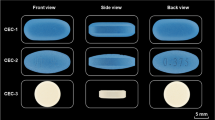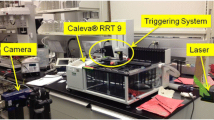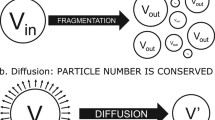ABSTRACT
Purpose
Most dissolution testing systems rely on analyzing samples taken remotely from the dissolving sample surface at different time points with poor time resolution and therefore provide relatively unresolved temporally and spatially information on the dissolution process. In this study, a flexible numerical model was combined with a novel UV imaging system, allowing monitoring of the dissolution process with sub second time resolution.
Methods
The dissolution process was monitored by both effluent collection and UV imaging of compacts of paracetamol. A finite element model (FEM) was used to characterize the UV imaging system.
Results
A finite element model of the UV imaging system was successfully built. The dissolution of paracetamol was studied by UV imaging and by analysis of the effluent. The dissolution rates obtained from the collected effluent were in good agreement with the numerical model. The numerical model allowed an assessment of the ability of the UV imager to measure dissolution—time profiles. The simulation was able to extend the experimental results to conditions not easily obtained experimentally.
Conclusions
Combining FEM,experimental dissolution data and UV imaging provided experimental validation of the FEM model as well as a detailed description of the dissolution process.








Similar content being viewed by others
Abbreviations
- A:
-
radius of circular compact
- C:
-
concentration
- Csat :
-
saturation concentration
- d:
-
flow channel width
- D:
-
diffusion coefficient
- DH :
-
hydraulic diameter
- F:
-
mass flux of dissolving compound
- FEM:
-
finite element method
- H:
-
characteristic length defined as the height of the flow cell over the compact
- J:
-
dissolution rate
- Pe:
-
Peclet number
- Ps :
-
shear Peclet number
- Q:
-
volumetric flow rate
- Re:
-
Reynolds number
- u:
-
velocity
- U:
-
average linear flow rate
- USP:
-
United States pharmacopeia
- UV:
-
ultraviolet
- Vf :
-
volumetric flow rate
- ν:
-
kinematic viscosity
- ρ:
-
density
REFERENCES
Siewert M, Dressman J, Brown CK, Shah VP. FIP/AAPS guidelines to dissolution/in vitro release testing of novel/special dosage forms. AAPS PharmSciTech. 2003;4:E7.
Gray V, Kelly G, Xia M, Butler C, Thomas S, Mayock S. The science of USP 1 and 2 dissolution: present challenges and future relevance. Pharm Res. 2009;26:1289–302.
Dressman JB, Amidon GL, Reppas C, Shah VP. Dissolution testing as a prognostic tool for oral drug absorption: immediate release dosage forms. Pharm Res. 1998;15:11–22.
Tong C, Lozano R, Mao Y, Mirza T, Löbenberg R, Nickerson B, et al. The value of in vitro dissolution in drug development. Pharm Technol. 2009;33:52–64.
Amidon GL, Lennernas H, Shah VP, Crison JR. A theoretical basis for a biopharmaceutic drug classification: the correlation of in vitro drug product dissolution and in vivo bioavailability. Pharm Res. 1995;12:413–20.
Mudie DM, Amidon GL, Amidon GE. Physiological parameters for oral delivery and in vitro testing. Mol Pharm. 2010;7:1388–405.
Lehto P, Aaltonen J, Tenho M, Rantanen J, Hirvonen J, Tanninen VP, et al. Solvent-mediated solid phase transformations of carbamazepine: effects of simulated intestinal fluid and fasted state simulated intestinal fluid. J Pharm Sci. 2009;98:985–96.
Wilson D, Wren S, Reynolds G. Linking dissolution to disintegration in immediate release tablets using image analysis and a population balance modelling approach. Pharm Res. 2012;29:198–208.
Soto E, Haertter S, Koenen-Bergmann M, Staab A, Troconiz IF. Population in vitro-in vivo correlation model for pramipexole slow-release oral formulations. Pharm Res. 2010;27:340–9.
D’Arcy DM, Corrigan OI, Healy AM. Evaluation of hydrodynamics in the basket dissolution apparatus using computational fluid dynamics—dissolution rate implications. Eur J Pharm Sci. 2006;27:259–67.
Kukura J, Baxter JL, Muzzio FJ. Shear distribution and variability in the USP Apparatus 2 under turbulent conditions. Int J Pharm. 2004;279:9–17.
D’Arcy DM, Corrigan OI, Healy AM. Hydrodynamic simulation (computational fluid dynamics) of asymmetrically positioned tablets in the paddle dissolution apparatus: impact on dissolution rate and variability. J Pharm Pharmacol. 2005;57:1243–50.
Nelson KG, Shah AC. Convective diffusion-model for a transport-controlled dissolution rate process. J Pharm Sci. 1975;64:610–4.
Shah AC, Nelson KG. Evaluation of a convective diffusion drug dissolution rate model. J Pharm Sci. 1975;64:1518–20.
Missel PJ, Stevens LE, Mauger JW. Reexamination of convective diffusion/drug dissolution in a laminar flow channel: accurate prediction of dissolution rate. Pharm Res. 2004;21:2300–6.
Neervannan S, Reinert JD, Stella VJ, Southard MZ. A numerical convective-diffusion model for dissolution of neutral compounds under laminar-flow conditions. Int J Pharm. 1993;96:167–74.
Neervannan S, Dias LS, Southard MZ, Stella VJ. A convective-diffusion model for dissolution of 2 noninteracting drug mixtures from co-compressed slabs under laminar hydrodynamic conditions. Pharm Res. 1994;11:1288–95.
Greco K, Bergman TL, Bogner R. Design and characterization of a laminar flow-through dissolution apparatus: comparison of hydrodynamic conditions to those of common dissolution techniques. Pharm Dev Technol. 2011;16:75–87.
D’Arcy DM, Persoons T. Mechanistic modelling and mechanistic monitoring: simulation and shadowgraph imaging of particulate dissolution in the flow-through apparatus. J Pharm Sci. 2011;100:1102–15.
D’Arcy DM, Liu B, Persoons T, Corrigan OI. Hydrodynamic complexity induced by the pulsing flow field in USP dissolution apparatus 4. Dissolut Technol. 2011;18:6–13.
Østergaard J, Meng-Lund E, Larsen SW, Larsen C, Petersson K, Lenke J, et al. Real-time UV imaging of nicotine release from transdermal patch. Pharm Res. 2010;27:2614–23.
Østergaard J, Ye F, Rantanen J, Yaghmur A, Larsen SW, Larsen C, et al. Monitoring lidocaine single-crystal dissolution by ultraviolet imaging. J Pharm Sci. 2011;100:3405–10.
Boetker JP, Savolainen M, Koradia V, Tian F, Rades T, Müllertz A, et al. Insights into the early dissolution events of amlodipine using UV imaging and raman spectroscopy. Mol Pharm. 2011;8:1372–80.
Ye FB, Yaghmur A, Jensen H, Larsen SW, Larsen C, Ostergaard J. Real-time UV imaging of drug diffusion and release from Pluronic F127 hydrogels. Eur J Pharm Sci. 2011;43:236–43.
Pajander J, Baldursdottir S, Rantanen J, Ostergaard J. Behaviour of HPMC compacts investigated using UV-imaging. Int J Pharm. 2012;427:345–53.
Hulse WL, Gray J, Forbes RT. A discriminatory intrinsic dissolution study using UV area imaging analysis to gain additional insights into the dissolution behaviour of active pharmaceutical ingredients. Int J Pharm. 2012;434:133–9.
Ostergaard J, Jensen H. Simultaneous evaluation of ligand binding properties and protein size by electrophoresis and Taylor dispersion in capillaries. Anal Chem. 2009;81:8644–8.
Ye FB, Jensen H, Larsen SW, Yaghmur A, Larsen C, Ostergaard J. Measurement of drug diffusivities in pharmaceutical solvents using Taylor dispersion analysis. J Pharm Biomed. 2012;61:176–83.
Gordon S, Naelapää K, Rantanen J, Selen A, Müllertz A, Østergaard J. Real-time dissolution behavior of furosemide in biorelevant media as determined by UV imaging. Pharm Dev Technol. doi:10.3109/10837450.2012.737808.
Zhang W, Stone HA, Sherwood JD. Mass transfer at a microelectrode in channel flow. J Phys Chem-Us. 1996;100:9462–4.
Author information
Authors and Affiliations
Corresponding author
Rights and permissions
About this article
Cite this article
Boetker, J.P., Rantanen, J., Rades, T. et al. A New Approach to Dissolution Testing by UV Imaging and Finite Element Simulations. Pharm Res 30, 1328–1337 (2013). https://doi.org/10.1007/s11095-013-0972-0
Received:
Accepted:
Published:
Issue Date:
DOI: https://doi.org/10.1007/s11095-013-0972-0




